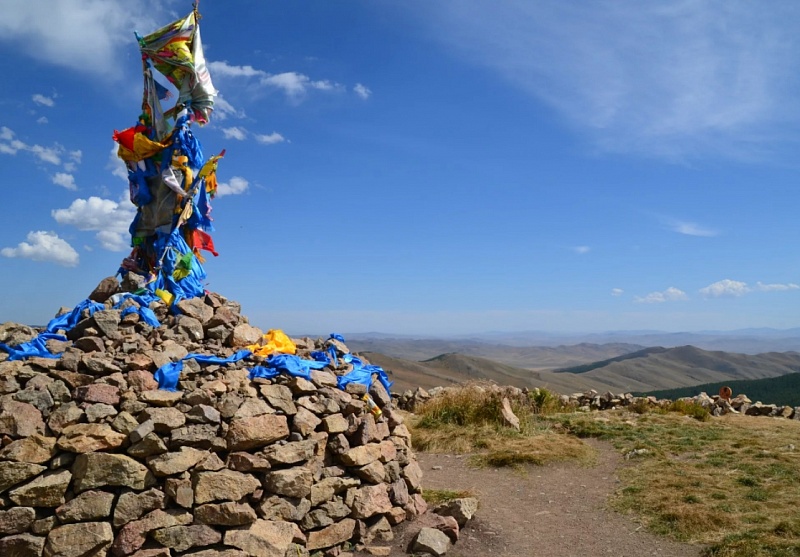The Mongolian shamans believed that the sky neither solid nor liquid and was, therefore, untouchable.
The shaman invocations related to the location of a shaman Ongon call:
The ones with etherial mantle,
The ones who pass from cloud to cloud,
The ones with ghostly silhouettes,
Watch them all vigilantly,
Listen to them carefully…
Therefore, in Shamanist belief, Heaven has no solid form, and its Ongon is similarly insubstantial. Thus, Heaven or Sky in Mongolian is “Ogtorgui”, which is composed of “Ogt” |at all| and “orgui” |there exists nothing|.
Because of these beliefs in Heaven, the higher mountains gained titles such as “Han Tenger |Sky|” and “Otgon Tenger”, These became the main places for national worship and offerings by the state. Moreover, across the world, many places were given similar names such as the “Cairn of Heaven”, “Heaven’s Tree” and so on. For example, a special “ovoo” |Cairn| was set up on a summit of the Hentii Han Mountains, and people named it “Ovoo of the Heaven”. Only aristocrats and Government officials were allowed toconduct prayers of national importance there. These prayers were conducted by a Zayran of divine origin with the participtation of the elites, aristocrats and public officials, who were also of Heavenly origin.
In response, the head of Mongolian Buddhism, Ondor Genggeen |Lofty Rimpoche| Zanabazar set up a new cairn, known as “Lama’s Cairn” on one of these peaks in the seventeenth century so that Lamas could pray there too.
Only lamas and some aristocratic Buddhists prayed there, where they were known to curse “Heaven’s Cairn”. Less important men and women, including ordinary Buddhists, were only allowed to around small cairns at the foot of the mountain.
Shaman believers considered the birth as a “Tree of Heaven”, because it is never struck by lighting. So, the Mongols often made the handles of weapons, tools and important possessions such as spear, spade, and ax hafts, saddles, and cradles from birch. Birch was also the material for the most powerful Shaman “orgols”. Moreover, the Mongols considered it as a sacred tree, so all of the most important historical documents, such as Altan Ordon’s Script and H.Perlee’s Collections of Laws, were written on birch bark. As mentioned above, fires especially sacred to the Mongols and dried birch bark was the tinder of choice for the Darhads and Tuvans. This use of birch meant that Heaven’s blessing covered ger, property, tools, instruments, weapons, fire-hearth and holy texts.
“Heaven’s Buumal” were important amulets among the Mongolian Shaman Ongons. The Buumal was a kind of tool or weapon used by people during the Bronze Age and generally found in places where lighting had struck. Therefore, the Shamanists of subsequent generations believed that they had been sent down from Heaven or by the Heaven Lord. At the start of the twentieth century, Jambal Zayran of Red Huular origin had a Buumal-amulet and his son Baljinnyam Zayran later inherited it from his father. V.Khaisseg carried out the first analysis of Heaven’s Buumal, and D.Mansan concluded, “The bulk of the scholars, that is, shaman researchers, considered it to be one of the most powerful among the ninety-nine Shaman Heavens. According to my own understanding, Heaven’s Buumals were ancient copper-alloy artefacts that were concealed by the earth. They were rediscovered or unearthed many years later when they were struck by lightning as a result of their high electrical conductivity. However, the Buumals were altered by natural events, and future generations assumed that they must have been sent down from Heaven and thus worshipped them as Shaman Ongons or their specific items.

